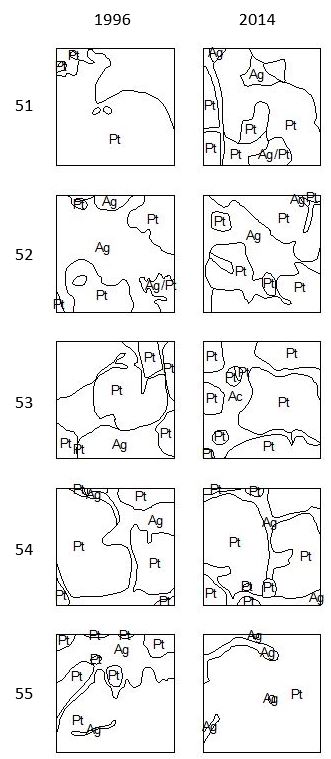Ground vegetation surveys were undertaken for the Denny Wood long and short transects in both 1996 and 2014. The long transect runs North to South and comprises 48 plots of 20m x 20m (with 2 plots not surveyed due to electrical infrastructure), please see Figures 1-10 for the ground flora vegetation surveys conducted in 1996 and 2014. The short transect runs West to East and comprises 16 plots, please see Figures 11-13 for these surveys. The 1996 maps have been redrawn from Mountford et al. 1999. Long-term change in growth, mortality and regeneration of trees in Denny Wood, an old-growth wood-pasture in the New Forest (UK). Perspectives in Plant Ecology, Evolution and Systematics, 2, 223-272.
Long transect
Figure 1: Ground vegetation survey plots 1 -5. Dominant ground vegetation species are identified as follows:
Ag, Agrostis spp.; Je, Juncus effusus; Mc, Molinia caerulea; Pt, Pteridium aquilinum. Numbers refer to plots.
Figure 2: Ground vegetation survey plots 6 -10. Dominant ground vegetation species are identified as follows:
Ag, Agrostis spp.; Je, Juncus effusus; Mc, Molinia caerulea; Pt, Pteridium aquilinum. Numbers refer to plots.
Figure 3: Ground vegetation survey plots 11 -15. Dominant ground vegetation species are identified as follows:
Ag, Agrostis spp.; Je, Juncus effusus; Mc, Molinia caerulea; Pt, Pteridium aquilinum. Numbers refer to plots.
Figure 4: Ground vegetation survey plots 16 -20. Dominant ground vegetation species are identified as follows:
Ag, Agrostis spp.; Je, Juncus effusus; Mc, Molinia caerulea; Pt, Pteridium aquilinum. Numbers refer to plots.
Figure 5: Ground vegetation survey plots 21-25. Dominant ground vegetation species are identified as follows:
Ag, Agrostis spp.; Je, Juncus effusus; Mc, Molinia caerulea; Pt, Pteridium aquilinum. Numbers refer to plots.
Figure 6: Ground vegetation survey plots 25-30. Dominant ground vegetation species are identified as follows:
Ag, Agrostis spp.; Je, Juncus effusus; Mc, Molinia caerulea; Pt, Pteridium aquilinum. Numbers refer to plots.
Figure 7: Ground vegetation survey plots 31-35. Dominant ground vegetation species are identified as follows:
Ag, Agrostis spp.; Je, Juncus effusus; Mc, Molinia caerulea; Pt, Pteridium aquilinum. Numbers refer to plots.
Figure 8: Ground vegetation survey plots 36 -40. Dominant ground vegetation species are identified as follows:
Ag, Agrostis spp.; Je, Juncus effusus; Mc, Molinia caerulea; Pt, Pteridium aquilinum. Numbers refer to plots.
Figure 9: Ground vegetation survey plots 41 -43. Dominant ground vegetation species are identified as follows:
Ag, Agrostis spp.; Je, Juncus effusus; Mc, Molinia caerulea; Pt, Pteridium aquilinum. Numbers refer to plots.
Please note: Plots 44 and 45 are not part of the transect.
Figure 10: Ground vegetation survey plots 45 -50. Dominant ground vegetation species are identified as follows:
Ag, Agrostis spp.; Je, Juncus effusus; Mc, Molinia caerulea; Pt, Pteridium aquilinum. Numbers refer to plots.
Short transect
Figure 11: Ground vegetation survey plots 51-55. Dominant ground vegetation species are identified as follows:
Ag, Agrostis spp.; Je, Juncus effusus; Mc, Molinia caerulea; Pt, Pteridium aquilinum. Numbers refer to plots.
Figure 12: Ground vegetation survey plots 56-60. Dominant ground vegetation species are identified as follows:
Ag, Agrostis spp.; Je, Juncus effusus; Mc, Molinia caerulea; Pt, Pteridium aquilinum. Numbers refer to plots.

Figure 13: Ground vegetation survey plots 61-66. Dominant ground vegetation species are identified as follows:
Ag, Agrostis spp.; Je, Juncus effusus; Mc, Molinia caerulea; Pt, Pteridium aquilinum. Numbers refer to plots.











